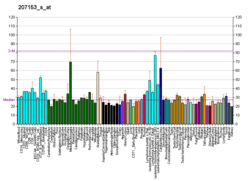GLMN
Glomulin is a protein that in humans is encoded by the GLMN gene.[5][6]
This gene encodes a phosphorylated protein that is a member of a Skp1-Cullin-F-box-like complex. The protein is essential for normal development of the vasculature and mutations in this gene have been associated with glomuvenous malformations, also called glomangiomas. Alternatively spliced variants that encode different protein isoforms have been described but the full-length nature of only one has been determined.[6]
Interactions
GLMN has been shown to interact with FKBP52,[5][7] C-Met[8] and FKBP1A.[5][7]
References
- 1 2 3 GRCh38: Ensembl release 89: ENSG00000174842 - Ensembl, May 2017
- 1 2 3 GRCm38: Ensembl release 89: ENSMUSG00000029276 - Ensembl, May 2017
- ↑ "Human PubMed Reference:".
- ↑ "Mouse PubMed Reference:".
- 1 2 3 Chambraud B, Radanyi C, Camonis JH, Shazand K, Rajkowski K, Baulieu EE (Jan 1997). "FAP48, a new protein that forms specific complexes with both immunophilins FKBP59 and FKBP12. Prevention by the immunosuppressant drugs FK506 and rapamycin". J Biol Chem. 271 (51): 32923–9. doi:10.1074/jbc.271.51.32923. PMID 8955134.
- 1 2 "Entrez Gene: GLMN glomulin, FKBP associated protein".
- 1 2 Neye, H (Mar 2001). "Mutation of FKBP associated protein 48 (FAP48) at proline 219 disrupts the interaction with FKBP12 and FKBP52". Regul. Pept. Netherlands. 97 (2–3): 147–52. doi:10.1016/S0167-0115(00)00206-8. ISSN 0167-0115. PMID 11164950.
- ↑ Grisendi, S; Chambraud B; Gout I; Comoglio P M; Crepaldi T (Dec 2001). "Ligand-regulated binding of FAP68 to the hepatocyte growth factor receptor". J. Biol. Chem. United States. 276 (49): 46632–8. doi:10.1074/jbc.M104323200. ISSN 0021-9258. PMID 11571281.
Further reading
- McIntyre BA, Brouillard P, Aerts V, Gutierrez-Roelens I, Vikkula M (2004). "Glomulin is predominantly expressed in vascular smooth muscle cells in the embryonic and adult mouse". Gene Expr. Patterns. 4 (3): 351–58. doi:10.1016/j.modgep.2003.09.007. PMID 15053987.
- Brouillard P, Vikkula M (2003). "Vascular malformations: localized defects in vascular morphogenesis". Clin. Genet. 63 (5): 340–51. doi:10.1034/j.1399-0004.2003.00092.x. PMID 12752563.
- Chambraud B, Radanyi C, Camonis JH, et al. (1999). "Immunophilins, Refsum disease, and lupus nephritis: The peroxisomal enzyme phytanoyl-COA α-hydroxylase is a new FKBP-associated protein". Proc. Natl. Acad. Sci. U.S.A. 96 (5): 2104–9. Bibcode:1999PNAS...96.2104C. doi:10.1073/pnas.96.5.2104. PMC 26744. PMID 10051602.
- Boon LM, Brouillard P, Irrthum A, et al. (1999). "A gene for inherited cutaneous venous anomalies ("glomangiomas") localizes to chromosome 1p21-22". Am. J. Hum. Genet. 65 (1): 125–33. doi:10.1086/302450. PMC 1378082. PMID 10364524.
- Brouillard P, Olsen BR, Vikkula M (2001). "High-resolution physical and transcript map of the locus for venous malformations with glomus cells (VMGLOM) on chromosome 1p21-p22". Genomics. 67 (1): 96–101. doi:10.1006/geno.2000.6232. PMID 10945476.
- Neye H (2001). "Mutation of FKBP associated protein 48 (FAP48) at proline 219 disrupts the interaction with FKBP12 and FKBP52". Regul. Pept. 97 (2–3): 147–52. doi:10.1016/S0167-0115(00)00206-8. PMID 11164950.
- Harrington JJ, Sherf B, Rundlett S, et al. (2001). "Creation of genome-wide protein expression libraries using random activation of gene expression". Nat. Biotechnol. 19 (5): 440–5. doi:10.1038/88107. PMID 11329013.
- Grisendi S, Chambraud B, Gout I, et al. (2002). "Ligand-regulated binding of FAP68 to the hepatocyte growth factor receptor". J. Biol. Chem. 276 (49): 46632–8. doi:10.1074/jbc.M104323200. PMID 11571281.
- Brouillard P, Boon LM, Mulliken JB, et al. (2002). "Mutations in a Novel Factor, Glomulin, Are Responsible for Glomuvenous Malformations ("Glomangiomas")". Am. J. Hum. Genet. 70 (4): 866–74. doi:10.1086/339492. PMC 379115. PMID 11845407.
- Strausberg RL, Feingold EA, Grouse LH, et al. (2003). "Generation and initial analysis of more than 15,000 full-length human and mouse cDNA sequences". Proc. Natl. Acad. Sci. U.S.A. 99 (26): 16899–903. Bibcode:2002PNAS...9916899M. doi:10.1073/pnas.242603899. PMC 139241. PMID 12477932.
- Krummrei U, Baulieu EE, Chambraud B (2003). "The FKBP-associated protein FAP48 is an antiproliferative molecule and a player in T cell activation that increases IL2 synthesis". Proc. Natl. Acad. Sci. U.S.A. 100 (5): 2444–9. Bibcode:2003PNAS..100.2444K. doi:10.1073/pnas.0438007100. PMC 151360. PMID 12604780.
- Arai T, Kasper JS, Skaar JR, et al. (2003). "Targeted disruption of p185/Cul7 gene results in abnormal vascular morphogenesis". Proc. Natl. Acad. Sci. U.S.A. 100 (17): 9855–60. Bibcode:2003PNAS..100.9855A. doi:10.1073/pnas.1733908100. PMC 187864. PMID 12904573.
- Gerhard DS, Wagner L, Feingold EA, et al. (2004). "The Status, Quality, and Expansion of the NIH Full-Length cDNA Project: The Mammalian Gene Collection (MGC)". Genome Res. 14 (10B): 2121–7. doi:10.1101/gr.2596504. PMC 528928. PMID 15489334.
- Kimura K, Wakamatsu A, Suzuki Y, et al. (2006). "Diversification of transcriptional modulation: Large-scale identification and characterization of putative alternative promoters of human genes". Genome Res. 16 (1): 55–65. doi:10.1101/gr.4039406. PMC 1356129. PMID 16344560.
This article is issued from
Wikipedia.
The text is licensed under Creative Commons - Attribution - Sharealike.
Additional terms may apply for the media files.




